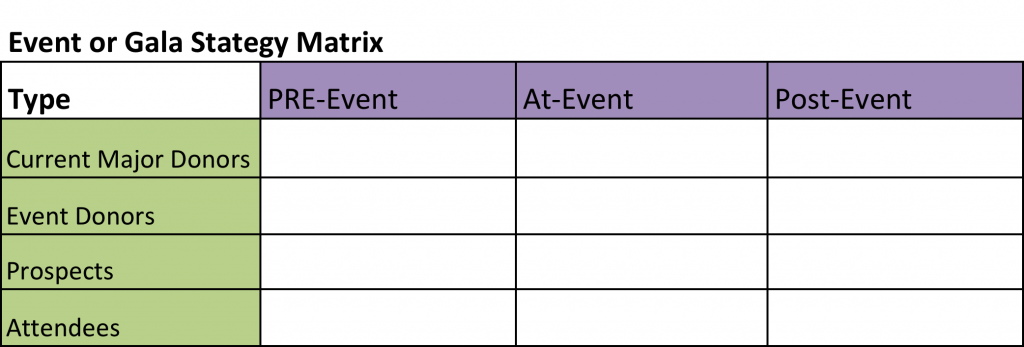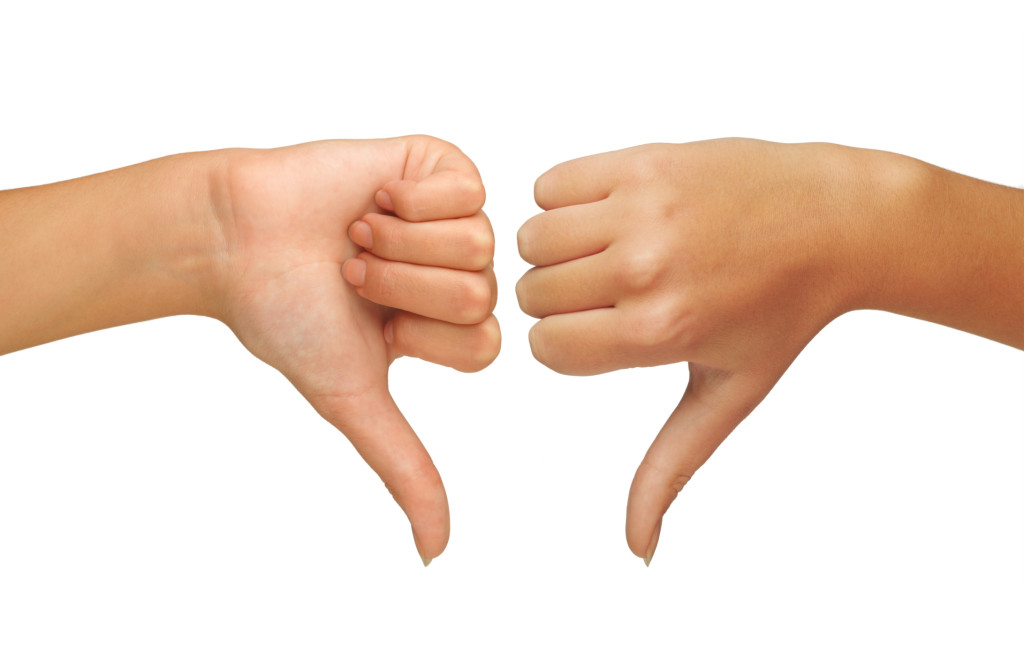Well, after the first post on this subject of events and galas I’ve had some really good conversations with folks. There are a ton of development professionals burdened by all the events that their non-profits are sponsoring. This is why Richard and I are not pro-event people in the first place. But again, if you are going to do an event… do it as strategically as possible.
What I’m hearing is that many of you get so caught up in the details that you lose sight of the donors. That is a disaster. Donors first, folks.
In this post, I promised you some actual tactics and details on how to think about each of these audiences. To get our mind wrapped around this I’ve included the Event Matrix once again. Use something like this to fill out your strategy for each audience.

With all four audiences you need a pre-event, at-event and post-event strategy. This is key, and you’ll blow it if you don’t have all three clearly thought through, with a way to execute for each audience.
Major Donors
Okay, let’s get started. For major donors, your MGOs will need to be brought in early to plan. Since it’s their caseload they ultimately own the strategy with their donors. So, work should be done by the MGO to determine the function of the event in the overall cultivation plan.
Pre-Event
- MGO determines by inquiring whether donors want to be invited to event.
- MGO determines type of invitation – letter only or phone call or personal visit.
- MGO works with leadership on whether to acknowledge the donor at event.
- MGO works with donors to help them strategize whom to invite at their table and obtains their contact information.
At-Event
- Development Director assigns each MGO to a specific table with his or her caseload donors.
- MGOs create a “talking point” plan for CEO and board and make connections with their donors.
- MGOs create a way to note all conversations and interests that come from their donors.
- MGOs reach out to all friends and family of their caseload donors and make efforts to connect with them and determine interest in mission.
Post-Event
- MGOs follow up with thank you notes to their caseload donors.
- MGOs follow up with requests or next steps donors brought up during the event.
- MGOs send letters to all caseload attendees to update them on the success of the event.
- Director of Development follows up with caseload donors’ contacts by notes and phone call.
Event Donors
Pre-Event
- Director of Development assigns specific people within organization (NOT MGOs) to help create a strategy for Event-only donors.
- Invitations are sent with the goal of upgrading this donor’s event contribution. (i.e., higher priced table, seats, etc.).
- Follow up to assure donors’ participation and whether they are inviting friends and family. Secure those names and contact information.
- Create At-Event strategy sheet for people assigned to donors.
At-Event
- Staff, board or other volunteers reach out with their assigned donors, invite to meet CEO and other board members.
- Create strategic conversations around mission with donors who have inclination to do more than attend event.
- If you haven’t already, obtain the names of guests of your donors.
- Note all conversations and interests of donors.
Post-Event
- Follow up to all donors by people assigned to them with notes and phone calls.
- Overall letter from CEO, thanking these donors with personal notes for specific donors who are interested in following up on the mission of the organization.
- Follow up on guests of donors. Do wealth screening and gauge future interest.
Prospects
The overall strategy with Prospects would be similar to event only donors, but here are a few key differences:
- Prospects would be assigned to those in your organization who brought them up as a prospect. That could mean a staff member, board member or CEO. This is key.
- The goal for the person assigned to that prospect is to engage in a conversation to determine interest, understand the needs and desire of the prospect as it could relate to the organization and get the prospect in front of leadership during the event.
- It’s then the responsibility of the assigned person to follow up and eventually hand off that prospect.
Attendees
Attendee strategy is contained in that for the audiences mentioned above because they are usually invited by one of these three. The key for the assigned person is to obtain his or her name and contact information and any information that the attendee volunteers.
And if an attendee makes a gift at the event, it needs to be followed up on immediately.
The key for attendees is an immediate thank you, feedback and follow up. The longer you wait to follow up, the harder it is to win them over. Once they show some type of interest, as the development director you need to address that interest, get them engaged and start cultivating a relationship.
Okay, there you have it. Remember, events are only going to be effective if they are donor-centered and planned for in a strategic manner. And, don’t allow your MGOs to get caught up in the weeds. They will never get out and you may never see them again.
Jeff




0 Comments